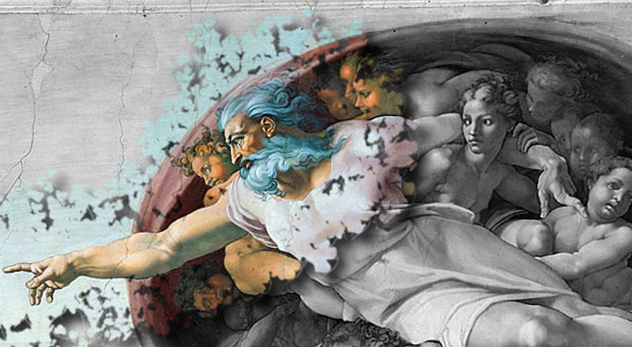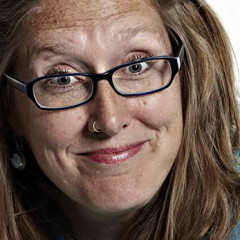
Author Margot Starbuck urges Christians to release false images of the Divine and embrace God’s true face. – Image courtesy of “Caveman Chuck” Coker http://bit.ly/1cWNf2V)
A.W. Tozer once said, “What comes into our minds when we think about God is the most important thing about us.”
So what comes into your mind when you think of God? A man or woman or an amorphous ball of light? Is this Being safe or dangerous, predictable or sporadic, gentle or temperamental? Author Margot Starbuck argues that many today believe in a mythical God–namely, an “old white guy”–and not the One who actually exists. In her book, “Not Who I Imagined: Surprised by a Loving God,” the Princeton Seminary graduate and seasoned writer encourages us to embrace a different God–one who loves us as we are, not as we should be. Here, we discuss her book and this provocative concept.
RNS: You claim that people assign a face—an image—to an invisible God. Say more.
MS: From an early age, our brains create a picture of an un-seeable God, and our experience of important people in our lives contributes—probably more than we realize—to that composite image. But we also glean God’s likeness from the representations of God we’ve seen and heard: an illustrated Bible storybook featuring bearded-Jesus, an oil painting of glowing-Jesus in the creepy basement of Grandma’s church, or, if we’re really sophisticated, a muscular 65-year-old pale-skinned deity peeled from the ceiling of the Sistine Chapel.
RNS: Are there other pop cultural images that influence how we see God?
Great question. One of the previous pastors at the church I attend had a deep booming voice, and people often remarked that “he sounded like God.” Where did they get that? How did they know God doesn’t have a high squeaky voice?
I’m pretty sure it was the 1956 Cecil B. DeMille “Ten Commandments” movie, starring Charlton Heston. Heston played Moses, but also performed God’s deep bass voice coming from the burning bush. In the late 1970’s, 81-yr-old George Burns played God in the “Oh, God” comedies. And, of course, a few films have since dared to present God as something other than an old white guy–Morgan Freeman, in “Bruce Almighty” or Alanis Morisette in “Dogma”—though I’m not sure the last few are gaining any real traction in the collective psyche over “old white guy.”
RNS: Do you think race and gender are significant in how we view God?
MS: Many of us say we know that God isn’t really male or white, but when William P. Young’s “The Shack” imaginatively portrayed the first person of the Trinity as an effervescent rotund black woman, a lot of the same folks got their hackles up. Personally, I think that assigning race and gender to God, the first person of the Trinity, are less important than the expression of the face we give to God.
RNS: Some folks would disagree with you on this point, no?
MS: Some might say that I’m speaking as a person whose life experience has been shaped as a member of the dominant culture.
But my friend Sameer Yadav, who teaches at Indiana Wesleyan University, and is Indian, has helped me see differently. He grew up as a brown person in Idaho, and was fed images of Gary Larson’s white, robed, bearded “Far Side” god. Sameer expressed it so beautifully said, “To the extent that I do not resemble the paradigm human person being inflated to come up with that image, I internalized it as an anxiety rather than as a living source of comfort.”
So race and gender do matter. But I’m still wanting to push people to notice what expression they’ve given to the face they assign to God.
RNS: But don’t people sometimes do a “good cop, bad cop” thing by formulating and an angry, Old Testament God who morphs into the gracious, New Testament God?
MS: Sure. Jesus becomes the chummy grinning friend and we conceive of Jesus’ Father as the cosmic bad guy who demands satisfaction for sin. But Jesus knew how we are. And one of the last conversations he had with his disciples was about this very thing.
When his friend Philip asked Jesus to show him the Father, Jesus was like, “Dude! I’m it. If you’ve seen me, you’ve seen the Father. Same face. If you want to peek at the Father, look at me—there’s no difference. When I graciously receive a woman who’s had five husbands or forgive someone caught in adultery or move toward a despised tax collector, that’s the face of my Father.”
RNS: So where’s the good news in all this?
MS: I think the good news is that we’re invited to choose and live into a truer story. Right now, the story a lot of us tell is that when we were saved—the moment we prayed the “Sinner’s Prayer” or were baptized—God smiled upon us. And then, when we die, as we’re jettisoned off into the clouds—the ones with the pearly gates we’ve seen in Warner Brothers cartoons—we’ll be warmly embraced by God into our heavenly home.
But what about every moment in between?
The good news of the gospel is that, because of Jesus, God receives us right now as we are and not as we should be.







